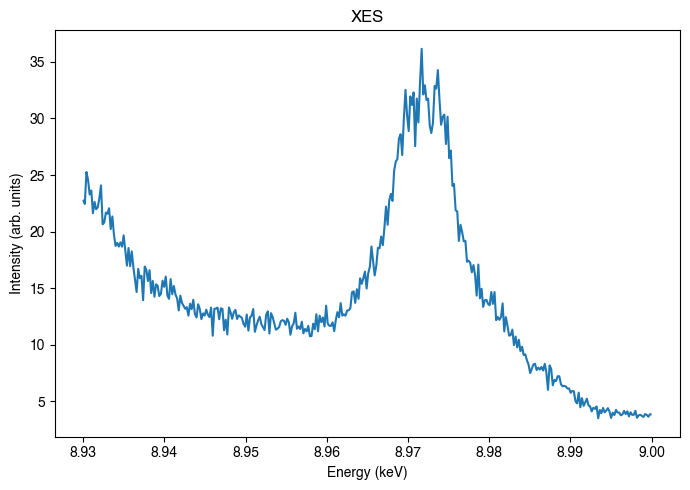X-ray emission: concentration correction and plotting#
Import all the required libraries. When using daxs for XES scans, import the Xes class.
[1]:
import matplotlib.pyplot as plt
from daxs.measurements import Xes
from daxs.sources import Hdf5Source
from daxs.utils import resources
Define the counters to process data for XES
[2]:
hdf5_filename = resources.getfile("A1_Kb_XES.h5")
counters = {
"x": ".1/measurement/xes_en", # The X-axis, here the emission energy.
"signal": ".1/measurement/det_dtc_apd", # The data counter, here is the APD with dead-time correction. # noqa
"monitor": ".1/measurement/I02", # The counter used for normalization.
}
[ ]:
resources.download_all()
Define the data file and the scan numbers. Give first the filename, then the numbers of scans to include, then the numbers of scans to exclude (if any), and finally the counters defined above.
[3]:
source = Hdf5Source(hdf5_filename, [8], data_mappings=counters)
Define the scan number for the concentration correction scan.
[4]:
conc_corr_scan = 9
Create an object that contains the measured data and has included functionality for processing the data. Here we use the measurement class Xes. The data is defined in the source object above.
[5]:
measurement = Xes(source)
Adjusts the measured data by the concentration correction.
[6]:
measurement.concentration_correction(conc_corr_scan)
Optionally, you can find the outliers in the data and removes them. The threshold value can be used to adjust the behavior.
[7]:
measurement.find_outliers(threshold=9)
measurement.remove_outliers()
Optionally, you can normalize the data, which can be area or maximum.
[8]:
measurement.normalize(mode="area")
Plot the x, and the y data of the measurement defined above.
[9]:
fig, ax = plt.subplots(figsize=(7, 5))
ax.set_xlabel("Energy (keV)")
ax.set_ylabel("Intensity (arb. units)")
ax.plot(measurement.x, measurement.signal) # The x and y values to plot.
ax.set_title("XES")
plt.tight_layout()
plt.show()
